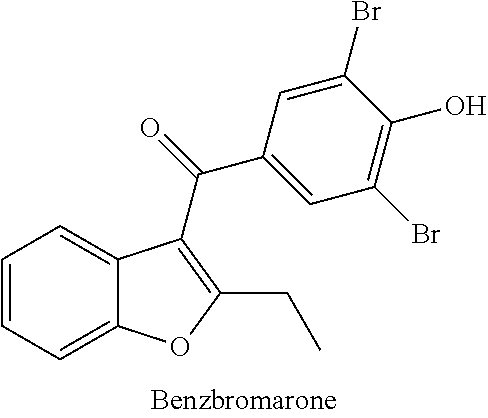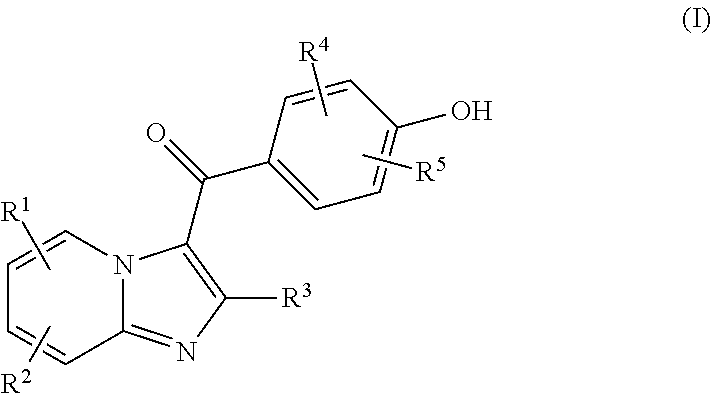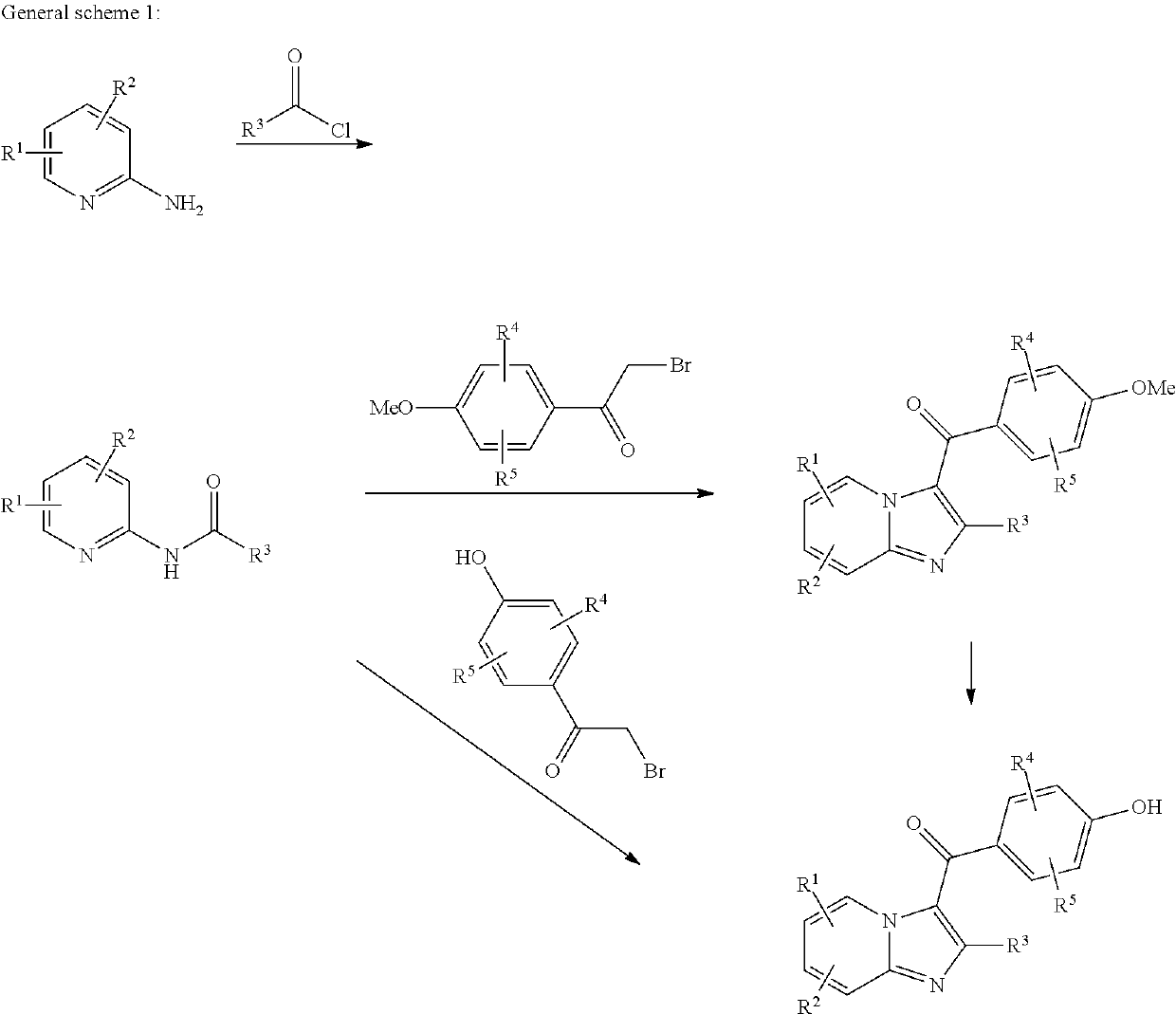Compound for treating or preventing hyperuricemia or gout
a gout and hyperuricemia technology, applied in the field of medical chemistry, can solve the problems of high toxicity of colchicine, inability to reduce the concentration of sua, painful inflammatory arthritis, etc., and achieve the effects of affecting the long-term use of these gout medicines, low toxicity, and high efficacy
- Summary
- Abstract
- Description
- Claims
- Application Information
AI Technical Summary
Benefits of technology
Problems solved by technology
Method used
Image
Examples
example 2
of (2-ethylimidazo[1,2-a]pyridine-3-yl)(4-hydroxy-3,5-diiodophenyl)methanone (5)
[0070]
[0071]A mixture of compound 3 (556 mg, 2.09 mmol), sodium acetate (367 mg, 4.58 mmol) and iodine (1.17 g, 4.61 mmol) in methanol (20 mL) was stirred under reflux for 1 h. Then a solution of sodium hydroxide (151 mg, 3.78 mmol) in water (20 mL) was added. The reaction mixture was stirred under reflux for 1 h and cooled to room temperature. Saturated aqueous sodium bisulfate (20 mL) was added. The precipitates formed were collected by filtration, washed with water, and dried. The crude product was crystallized from petroleum ether / ethyl acetate to give (2-ethylimidazo[1,2-a]-pyridine-3-yl)(4-hydroxy-3,5-diiodophenyl)methanone (5) (924 mg) with 85.3% yield. 1H NMR (DMSO-d6, 300 MHz) δ 9.17 (d, J=6.9 Hz, 1H), 8.05 (s, 2H), 7.75 (d, J=9.0 Hz, 1H), 7.64-7.58 (m, 1H), 7.22-7.17 (m, 1H), 2.45 (q, J=7.5 Hz, 2H), 1.17 (t, J=7.5 Hz, 3H). MS (EI, m / z): 518.8 [M+H]+.
example 3
of (3-chloro-4-hydroxyphenyl)(2-ethylimidazo[1,2-a]pyridin-3-yl)methanone (8) and (3-chloro-4-hydroxy-5-iodophenyl)(2-ethylimidazo[1,2-a]-pyridin-3-yl)methanone (9)
[0072]
[0073]Step A: A solution of 2-bromoacetyl bromide (6.8 g, 33.7 mmol) in anhydrous dichloromethane (10 mL) was added dropwise into a mixture of 1-chloro-2-methoxybenzene (4.0 g, 28.1 mmol) and aluminum chloride (4.12 g, 30.9 mmol) in anhydrous dichloromethane (30 mL) in an ice bath. After addition, the reaction mixture was stirred for another 1.5 h and poured into ice-water (100 mL). The mixture was extracted with dichloromethane (60 mL×3). The combined organic layer was washed with water (30 mL), saturated sodium bicarbonate (30 mL×2), water (30 mL) and brine (30 mL), dried over anhydrous sodium sulfate, filtered through a short silica gel pad, and concentrated under vacuum. The residue was recrystallized with petroleum ether / dichloromethane to get 2-bormo-1-(3-chloro-4-methoxyphenyl)ethanone (6) (3.37 g) with 45.5%...
example 4
of 3-chloro-5-(2-ethylimidazo[1,2-a]pyridine-3-carbonyl)-2-hydroxybenzonitrile (10)
[0077]
[0078]A mixture of compound 9 (393 mg, 0.921 mmol) and cuprous cyanide (124 mg, 1.38 mmol) in DMF (5 mL) was stirred at 130° C. overnight, cooled to room temperature, diluted with water (30 mL), and extracted with ethyl acetate (30 mL×3). The combined organic layer was washed with water (20 mL×2) and brine (10 mL), dried over anhydrous sodium sulfate, filtered, and concentrated under vacuum. The residue was purified by flash column chromatography on silica gel (eluted with ethyl acetate / petroleum ether=2:1-5:1) to afford 3-chloro-5-(2-ethylimidazo[1,2-a]pyridine-3-carbonyl)-2-hydroxybenzonitrile (10). 1H NMR (DMSO-d6, 300 MHz) δ 9.11 (d, J=6.3 Hz, 1H), 7.94-7.90 (m, 2H), 7.80-7.77 (m, 1H), 7.68-7.63 (m, 1H), 7.26-7.21 (m, 1H), 2.50-2.48 (m, 2H), 1.17 (t, J=7.2 Hz, 3H). MS (EI, m / z): 324.0 [M−H]−.
PUM
| Property | Measurement | Unit |
|---|---|---|
| concentration | aaaaa | aaaaa |
| temperature | aaaaa | aaaaa |
| temperature | aaaaa | aaaaa |
Abstract
Description
Claims
Application Information
 Login to View More
Login to View More - R&D
- Intellectual Property
- Life Sciences
- Materials
- Tech Scout
- Unparalleled Data Quality
- Higher Quality Content
- 60% Fewer Hallucinations
Browse by: Latest US Patents, China's latest patents, Technical Efficacy Thesaurus, Application Domain, Technology Topic, Popular Technical Reports.
© 2025 PatSnap. All rights reserved.Legal|Privacy policy|Modern Slavery Act Transparency Statement|Sitemap|About US| Contact US: help@patsnap.com



